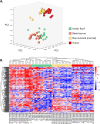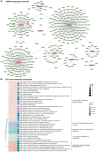Distinctive features of blood- and ascitic fluid-derived extracellular vesicles in ovarian cancer patients
- PMID: 40259212
- PMCID: PMC12010555
- DOI: 10.1186/s10020-025-01177-7
Distinctive features of blood- and ascitic fluid-derived extracellular vesicles in ovarian cancer patients
Abstract
Background: Ovarian cancer (OC) is a highly aggressive malignancy characterized by early dissemination of cancer cells from the surface of the ovary to the peritoneum. To gain a deeper understanding of the mechanisms associated with this intraperitoneal spread, we aimed to characterize the role of extracellular vesicles (EVs) in metastatic colonization in OC.
Methods: To this purpose, a total of 150 samples of ascitic fluids, blood serum, tumor and normal tissues from 60 OC patients, were extensively analyzed to characterize the EVs released in blood and ascitic fluids of OC patients, in terms of size, expression of superficial epitopes and abundance of miRNAs biocargo.
Results: A statistically significant difference in the size of EVs derived from ascitic fluid and serum was identified. Analysis of surface protein expression highlighted twenty epitopes with a significant difference between the two biological matrices, of which 18 were over- and two were under-expressed in ascitic fluid. With regard to miRNA levels, Principal Component Analysis (PCA) assessed four distinct clusters representing tumor tissue, normal tissue, ascitic fluid, and serum. A prominent difference in circulating miRNAs was observed in serum and ascitic fluid highlighting 98 miRNAs significantly deregulated (P-adj < 0.05) between the two bodily fluids. Deregulated miRNAs and epitopes underline an enrichment in ascites in components contributing to the metastatic spread.
Conclusion: The results highlight a clear difference between the two biological fluids, suggesting that tumor selectively releases specific EVs populations in serum or ascites. In this context, it seems that ascites-derived EVs play a major role in modulating EMT and metastatic cascade, which is a key feature of OC.
Keywords: Extracellular vesicles; Metastasis; Metastatic spread; Ovarian cancer; miRNA.
© 2025. The Author(s).
Conflict of interest statement
Declarations. Ethics approval and consent to participate: Patients’ samples were collected after providing informed consent and the study was approved by IRB (788/2021/Sper/AOUBo). The study was performed in accordance with the Declaration of Helsinki. Consent for publication: Not applicable. Competing interests: The authors declare no competing interests.
Figures








References
MeSH terms
Substances
LinkOut - more resources
Full Text Sources
Medical

